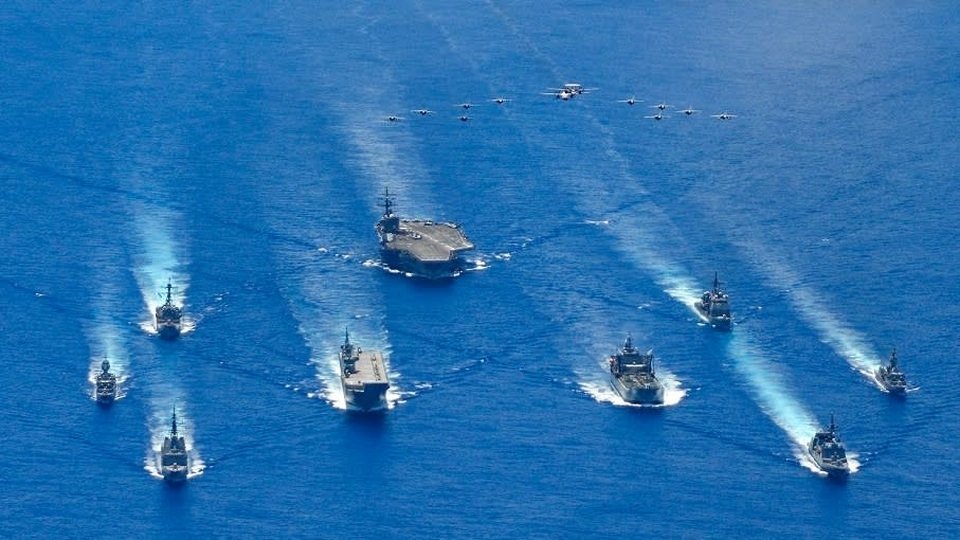(Dan Tri) – Recent US exercises have shown the strategy to deal with submarine power, considered China’s `trump card` in the East Sea.
The aircraft carrier USS Ronald Reagan and US warships exercised with ships from the Australian and Japanese navies on July 21.
From July to September this year, the US and China continuously conducted military exercises in the East Sea.
Observing US and Chinese exercises can help make observations about how the two countries’ militaries will operate in the event of a real conflict.
According to Nikkei, as for China, it may be using `distraction` tactics.
The Chinese People’s Liberation Army has mobilized forces for simultaneous exercises on all four fronts in recent months, including the East Sea, East China Sea, Yellow Sea and the China-India border.
In the area around Vietnam’s Paracel Islands, China’s Southern Theater Command, which oversees army, air force and navy forces in China’s south and the South China Sea,
At the same time, the Northern Theater Command, which oversees forces in northern China and the Korean peninsula, conducted exercises in the Yellow Sea.
The maritime exercises take place amid a tense conflict between Chinese and Indian soldiers in a disputed border area in the Himalayas.
Japanese security officials are concerned about the possibility that China is trying to attract the world’s attention to one area, but in fact is secretly acting to achieve strategic goals in another area.
This tactic has been used by China historically.
However, the US seems to have seen through China’s tactics.
`Deploying two aircraft carriers has a different meaning than deploying just one,` said a former senior intelligence official at the Japanese Ministry of Defense.
If only one aircraft carrier was deployed, an enemy attack could cripple the ship and the fighters would have no place to land.
The US `reads` China’s tactics?

Type-92 submarine of the Chinese navy.
The US’s choice of the East Sea as an exercise location is said to target the place where China can deploy its final combat option: strategic nuclear submarines equipped with ballistic missiles.
In the event of a nuclear conflict, the United States will not be willing to attack China’s most important target, if Beijing maintains the ability to attack with submarine-launched ballistic missiles.
To protect this `trump card`, China has built artificial islands in the East Sea and strengthened its defense capacity with missiles and fighter aircraft.
If the US can neutralize China’s submarine-launched ballistic missiles, Washington can significantly weaken Beijing’s combat capabilities, whether in wartime or peacetime.
Analysis of exercises in July shows that the US plan in the event of a conflict with China will be to use aircraft launched from aircraft carriers, coordinating with other forces to destroy the islands.
A US move in mid-August reinforced the above scenario.
The above information sent a strong message that: If conflict occurs, US forces can cause Chinese submarines to have no way back.

US fast attack submarine USS Missouri.
Angered by the US move, China continued to conduct an exercise in the East Sea at the end of August.
According to SCMP, the Chinese military launched a number of missiles on August 26, including at least one DF-26 missile – a medium-range missile known as the `Guam Killer` with the ability to attack
In the event that the US destroys China’s submarine-launched ballistic missiles and Beijing responds with an attack on Guam, US ballistic missile-equipped submarines will still be safe in the waters.
Recent exercises show that in terms of strategy, the US still has superiority over China, at least at the present time.
However, in the long term, China will likely continue to refuse to participate in arms control negotiations with Russia and the United States, while still increasing the development of nuclear weapons, ballistic missiles and maritime vessels.
The US repeatedly invited China to participate in trilateral negotiations on the future of the New Strategic Arms Reduction Treaty (New START), but Beijing refused.
A report from the US Department of Defense on September 1 said that in the next decade, China wants to double the number of more than 200 nuclear warheads that Beijing currently has.
China has asserted that the number of nuclear weapons it possesses is only a small fraction of that of Russia and the United States.
Meanwhile, the US government considers China’s small (only 1/5 of the US or Russia’s) but increasingly powerful nuclear arsenal to be a threat that both Moscow and Washington should cooperate with.
